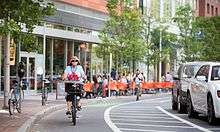Bike lane
Bike lanes (US) or cycle lanes (UK) are types of bikeways (cycleways) with lanes on the roadway for cyclists only. In the United Kingdom, an on-road cycle-lane can be firmly restricted to cycles (marked with a solid white line, entry by motor vehicles is prohibited) or advisory (marked with a broken white line, entry by motor vehicles is permitted). In the United States, a designated bicycle lane (1988 MUTCD) or class II bikeway (Caltrans) is always marked by a solid white stripe on the pavement and is for 'preferential use' by bicyclists. There is also a class III bicycle route, which has roadside signs suggesting a route for cyclists, and urging sharing the road. A class IV separated bike way (Caltrans) is a bike lane that is physically separate from motor traffic and restricted to bicyclists only.

In France, segregated cycling facilities on the carriageway are called bande cyclable, those beside the carriageway or totally independent ones piste cyclable, all together voie cyclable.[1] In Belgium, traffic laws do not distinguish cycle lanes from cyclepaths. Cycle lanes are marked by two parallel broken white lines, and they are defined as being "not wide enough to allow use by motor vehicles". There is some confusion possible here: both in French (piste cyclable) and in Dutch (fietspad) the term for these lanes can also denote a segregated cycle track, marked by a road sign; the cycle lane is therefore often referred to as a "piste cyclable marquée" (in French) or a "gemarkeerd fietspad" (in Dutch), i.e. a cycle lane/track which is "marked" (i.e. identified by road markings) rather than one which is identified by a road sign. In the Netherlands the cycle lane is normally called "fietsstrook" instead of "fietspad".
According to a 2019 study, cities with separated bike lanes had 44% fewer road fatalities and 50% fewer serious injuries from crashes. The relationship was particularly strong in cities were bike lanes were separated from car lanes with physical barriers.[2][3] Research published in 2020 showed insights from communities where on-road cycling for transportation is less common, particularly in the Southeast U.S. and reported that potential bikers say separated bike lanes would make them more likely to participate in active transportation. [4]
See also
- Bikeway safety, including studies on the safety of cycle tracks
- Bikeway and legislation
- Cycling infrastructure
References
- French bicycle association FUBi, Pistes et bandes cyclables
- Marshall, Wesley E.; Ferenchak, Nicholas N. (2019-05-29). "Why cities with high bicycling rates are safer for all road users". Journal of Transport & Health. 13: 100539. doi:10.1016/j.jth.2019.03.004. ISSN 2214-1405.
- "Separated Bike Lanes Means Safer Streets, Study Says". Streetsblog USA. 2019-05-29. Retrieved 2019-06-01.
- "Bicyclist Facility Preferences and Effects on Increasing Bicycle Trips". Transportation Research Board, National Academies of Sciences, Engineering, and Medicine. 2020-05-07.
External links
- Urban Bikeway Design Guide from National Association of City Transportation Officials
